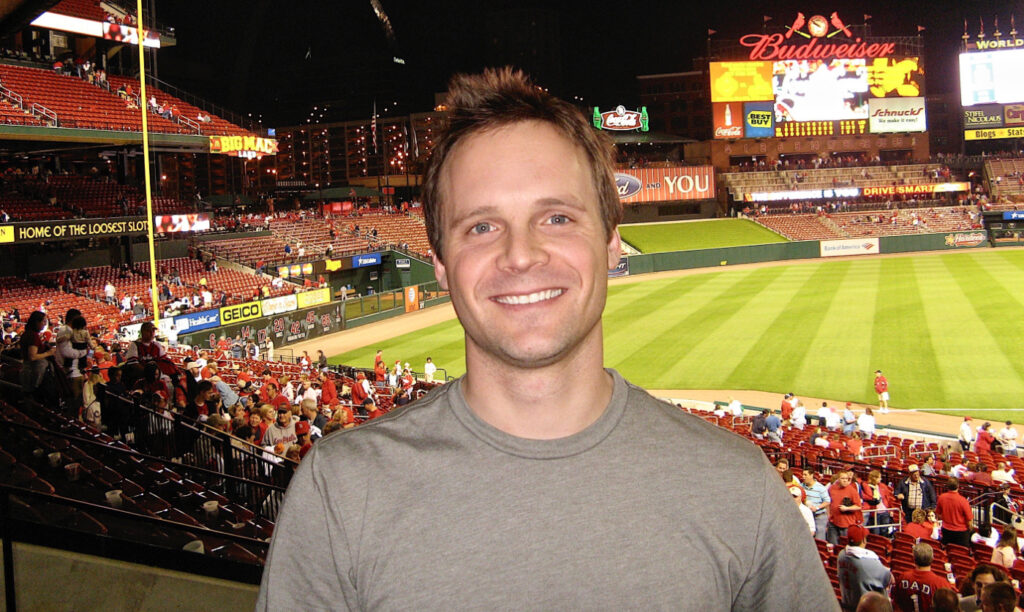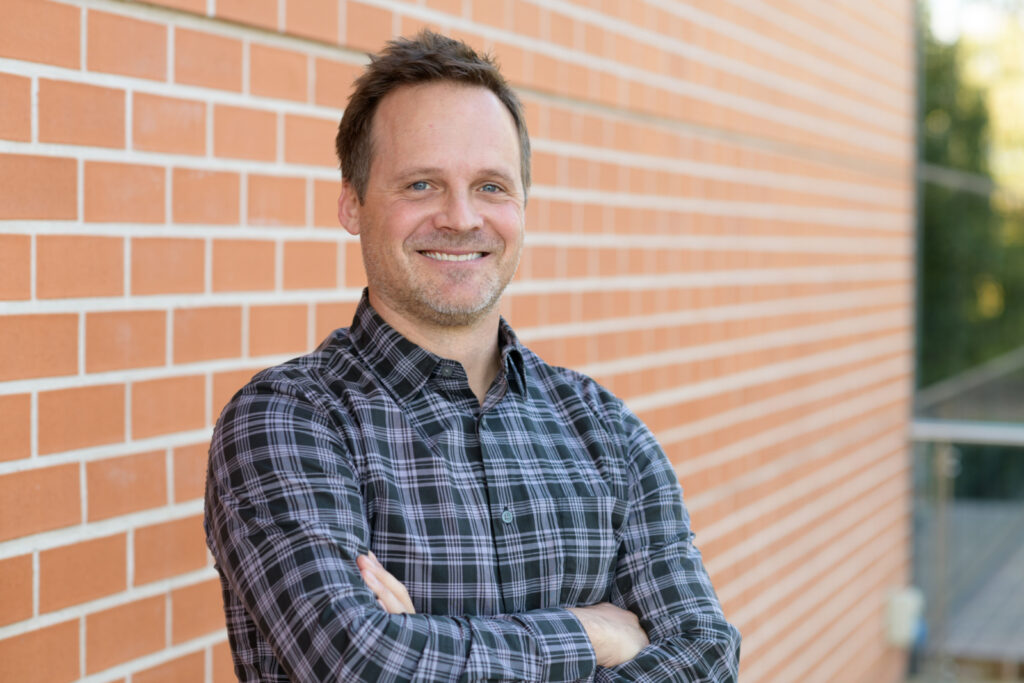Ten years ago, baseball bans were seized by an exhausting World Series. In the 10th inning of Game 6, the Texas Rangers and the St. Louis Cardinals were tied 9–9 and headed into an 11th. The Rangers made no headway in the first half of the 11th. Everybody’s nails were bitten to the quick. It was chilly and way past kids’ bedtime, but Busch stadium was still packed. At the start of the bottom of the inning, Cardinals third baseman David Freese stepped up to the plate, stared down Rangers pitcher Mark Lowe, and hit a walkoff home run to tie up the series. “We will see you tomorrow night!” yelled announcer Joe Buck.
Two days later, David Kaplan found himself in a mob of Cardinals fans parading down Market Street in downtown St. Louis. The night before, the red birds had won 6–2, so Kaplan, then a postdoc at Washington University School of Medicine, and his wife joined the championship celebration. Although he played baseball as a kid and loved to watch it, Kaplan’s reverence for the sport went beyond mere fandom and deep into scientific inquiry. “When you see a batter hit a home run, how does it go from a pattern of light on the retina to a precise sequence of muscle contractions in the limbs that produce a perfectly timed swing of the bat? From the earliest days of my undergrad, I was intrigued by those questions,” Kaplan says.

During his PhD at Duke University, Kaplan began seeking answers. His approach to understanding how sensory inputs are transformed into motor commands has been part philosophy and part neuroscience. Now, as the Director of the Cognitive and Brain Sciences degree in the School of Psychological Sciences at Macquarie University in Sydney, Kaplan continues to pursue those questions related to sensory-motor integration. “I think he’s done fantastically well,” says Lawrence Snyder, MD, PhD, a professor in the Department of Neuroscience in the School of Medicine who was one of Kaplan’s postdoctoral advisors. “I like the idea that as a lab we’re able to train a cognitive neuroscientist and give him tools do to things that are really different from what we do.”
On good science
For his graduate work at Duke, Kaplan studied the connections between spatial perception and action—how the brain integrates visual information for the purposes of controlling movement. His thesis committee included artificial intelligence experts, philosophers and neuroscientists, including Dale Purves, MD, the Geller Professor of Neurobiology at Duke, who was a faculty member at Washington University School of Medicine in the 1970s and ‘80s, when the Department of Neuroscience was known as the Department of Anatomy and Neurobiology. His textbooks have formed the basis of countless neuroscience courses worldwide.
From conversations with Purves and coursework in neuroscience, Kaplan became intrigued by the methodological diversity related to his work, from fMRI studies in humans to single unit electrophysiological recordings in animals. “A lot of my PhD was thinking not just about the theory of how spatial representation and action link up, but what is the right way to forge links between findings from various areas of neuroscience that focus on different levels of brain organization,” Kaplan says.
This fascination with how best to integrate scientific discoveries across different levels—from the molecular to the behavioral—into a complete understanding of how a phenomenon occurs was what led Kaplan to WashU in the first place, for his first postdoc in the Philosophy-Neuroscience-Psychology program in Arts & Sciences. He worked with Professor Carl Craver, PhD, to address what Kaplan calls “a basic philosophy of science question”: what makes a good explanation in neuroscience? Since that time, Craver and Kaplan have maintained a productive collaboration. In their 2018 paper in the British Journal for the Philosophy of Science, for example, they sought to answer a question that is foundational to nearly all working neuroscientists when they are dealing with complex data and models: when is an explanation improved by adding details and when is it improved by dropping details?

During this time, Kaplan was connecting with researchers at the School of Medicine and attending their lab meetings. He was particularly drawn to the work of Snyder, who studies how the brain represents space and transforms that spatial information into motor plans. Snyder, who is affiliated with the Philosophy-Neuroscience-Psychology program, was similarly interested in how his own work fits into the broader scientific enterprise to understand how the mind and brain work. “Larry taught me the value of interacting widely across the scientific community and not letting traditional disciplinary boundaries stand in the way of making progress on an important research question,” says Kaplan. “It’s a model for how we make progress on these really complicated questions. Larry’s lab was a microcosm of that.”
Kaplan was ready to make his own inter-campus move, and he joined the Snyder lab for a second postdoc. “I had no wet lab experience. It was a radical jump,” Kaplan says.
A philosopher with an electrode
Snyder’s lab uses electrophysiological recordings of single neurons in the brain—arguably one of the most technically intricate methods in neuroscience. Although Kaplan came without any bench skills, Snyder says, “I thought, no matter what he actually does as far as collecting data, he’s going to be someone who makes us think about things in different ways.”
With the patient tutelage of Snyder and other lab members, Kaplan mastered electrophysiology. His goal was to follow up on a major advance Snyder’s lab had previously made, showing that individual cells in the parietal cortex encode information about both eye position and arm position. What wasn’t clear was which sensory inputs were giving information about limb position—was it visual, proprioceptive, or some combination of the two?
Something I’ll remember with fondness about WashU was the highly collaborative neuroscience community that wasn’t afraid to cross disciplinary boundaries.
David Kaplan, PhD
To figure that out, he set out to train monkeys in a task in which they had to plan a reach to a target on a screen. With their reaching arm under a mirrored panel and out of sight, Kaplan would manipulate the visual feedback they received about where their hand was located to determine how this influenced neural activity in parts of the parietal cortex known to be involved in reach planning. Kaplan pioneered a new paradigm in the lab to address this question and collected key results that the lab is continuing to follow up on.
Another project Snyder says Kaplan was instrumental to was part of an effort to answer a question about the topographic organization of neurons in higher-order, associative areas of the brain such as the parietal cortex. Unlike primary sensory and motor cortex, the maps contained in these areas are not nearly as orderly or complete. The question is, why? Kaplan’s contribution was to propose that, rather than merely being topographically arranged in the conventional sense that adjacent neurons represent adjacent locations in visual space, the cells might also be organized by task, such as fixating on or covertly attending to an object. “It was a completely different way of thinking about topographic organization,” says Snyder.
To Australia and the operating room
Kaplan says he loved living in the Central West End neighborhood of St. Louis, and he took advantage of the restaurants and music clubs nearby—even seeing Chuck Berry play at the Duck Room.
In 2013, Kaplan and his family—now expanded to include twin boys—left for Sydney where he would take a position in the Department of Cognitive Science (now the School of Psychological Sciences) at Macquarie University. His work there has focused on human motor learning and, specifically, how we adapt our movements to changes in the environment. The projects combine the basic question he approached during his PhD—how does the brain represent space?—with the pursuits in Snyder’s lab of understanding sensory-motor integration and the brain’s response to altered visual inputs.

One real-world setting in which this type of motor learning is critical is laparoscopic surgery, in which the surgeon’s view of their instrument movements on the screen is often mirror-reversed relative to their hand movements. Kaplan’s interest is to understand the strategies surgeons use to overcome these complications (his group has found they’re really good at it), with the ultimate goal of improving the ways surgeons are trained. One debate in the field, for instance, is whether the camera’s viewpoint should be adjusted to align with the surgeon’s perspective.
Last month, Kaplan’s team reported the results of a study in Scientific Reports showing that for expert surgeons and nonexperts alike, realigning visual feedback from a camera doesn’t actually help—although it serves to align camera and surgeon viewpoints, it also provides visual information that is inconsistent with the surgeon’s actual hand movements in the workspace and therefore impedes performance.
Kaplan says his time in Snyder’s lab was invaluable to how he approaches his research today—by pulling in perspectives from multiple fields. “People across the medical school were interested in the same basic questions on the brain and how it works. Something I’ll remember with fondness about WashU was the highly collaborative neuroscience community that wasn’t afraid to cross disciplinary boundaries.”
David Kaplan, PhD
Deputy Head and Associate Professor, Department of Cognitive Science, Macquarie University
WashU training: Postdoctoral researcher
Advisors:
- Carl Craver, PhD, Department of Philosophy (2007–2009)
- Larry Snyder, MD, PhD, Department of Neuroscience (2009–2013)
Expertise: Motor learning; philosophy of neuroscience
Favorite St. Louis spot: The Fox & Hounds Tavern at the Cheshire Hotel, Clayton
WashU highlight: Collaborations across departments, disciplines and campuses
